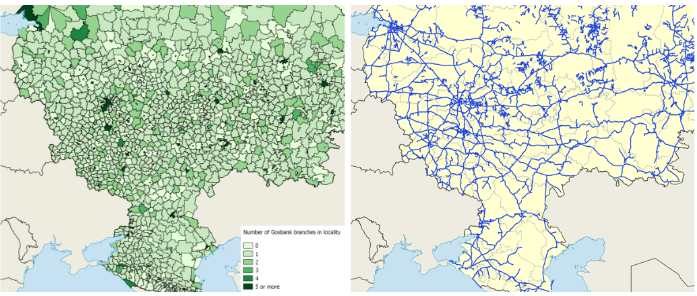Firm-level innovation in emerging markets often involves imitation – firms adopt ‘Western’ products and processes and adapt them to local circumstances. The speed with which technologies diffuse varies greatly from country to country and can explain up to a quarter of the total variation in national income levels (Comin and Hobijn, 2010). Despite this central role of technological diffusion in determining wealth, the mechanisms that underpin the spread of new products and production processes remain poorly understood.
In a recent paper (Bircan and De Haas 2019), we focus on one such mechanism: the role of credit constraints for technological adoption. Schumpeterian growth models predict that credit constraints can limit technological adoption because external inventions, which are typically context specific and involve tacit know-how, are costly to integrate into a firm’s production structure (Aghion et al. 2005).
To test whether credit constraints impede firm-level absorption of foreign technologies, we employ rich data from a regionally and sectorally representative sample of 4,220 Russian firms. We know the geographical location of each firm and have detailed survey-based information on their innovation activities, including the adoption of products and technologies that are new to them. By matching this information with panel data on these firms’ performance, we can also study whether adoptive innovation goes hand-in-hand with various productivity metrics.
To analyse the link between local availability of bank credit and firm-level technological adoption, we collect information on the location of over 45,000 Russian bank branches. This gives us an extensive and granular picture of Russia’s current banking landscape. The local density of bank branches and access to credit is likely to be endogenous to credit demand and other local characteristics. Our identification strategy therefore uses spatial heterogeneity in branch density induced by the top-down Soviet approach to economic planning as a source of exogenous variation in the present-day local supply of credit. To do so, we hand-collect and digitise historical data from archives in London, Kiev, and St. Petersburg to reconstruct a detailed spatial footprint, at the local level, of Soviet-era Gosbank (state bank) branches. We have made these new data publicly available and summarise them in the left-hand side of Figure 1 (with a focus on southwestern Russia). We also create a second historical banking instrument, using data from Berkowitz et al. (2014) on historical variation in the regional presence of spetsbanks. This variation reflects bureaucratic power struggles just before the collapse of the Soviet Union and has proven unrelated to past economic conditions.
Figure 1 Gosbank branches (left) and railway networks (right) in southwestern Russia
Note: The Gosbank data refer to 1979 and the railway data to 1989.
Source: Bircan and De Haas (2019) for data on Gosbank branches and the Vernadsky State Geological Museum (Moscow) and the US Geological Survey (2001) for geographical data on railway networks.
Banks and technological diffusion: Main findings
Our analysis provides three main insights into where and how access to credit can help facilitate technological diffusion:
- Our data demonstrate that firms are more likely to use bank credit in local markets where – for historical and exogenous reasons – the number of bank branches is higher. We then show that better access to credit promotes technological upgrading as it helps firms to produce new products and implement new production processes. This increased innovation in deeper credit markets occurs through cooperation with foreign clients and suppliers (in the context of product innovation) as well as the licensing of new technologies and hiring of business consultants (in the context of process innovation). We document that firms engaging in such innovation experience higher total factor productivity (TFP) and labour productivity growth than firms unable to innovate due to financial constraints. These findings speak to recent model calibrations of how financial frictions in emerging markets distort technology adoption decisions and hamper productivity growth (Midrigan and Xu 2014, Cole et al. 2016). We provide direct micro evidence from Russia in support of such models.
- We uncover substantial geographical variation in the impact of bank credit on technology adoption by firms. Russia’s geographical and institutional breadth allows us to assess under which conditions the availability of bank credit encourages firms to adopt new products and technologies. We show that firms located closer to R&D centres established during the Soviet period, and firms with easier access to foreign markets (as proxied by distance to railway networks: see right-hand panel of Figure 1), are more likely to adopt new products and technologies due to deeper credit markets. Moreover, access to credit only appears to stimulate firm innovation in regions with relatively high-quality institutions.
- We also uncover substantial sectoral variation in the impact of bank credit on firm-level technology adoption. Based on recent insights from Schumpeterian growth theory, we exploit assorted important dimensions of sector heterogeneity. We find that the link between bank lending and innovation is more pronounced in industries located further from the technological frontier; are more exposed to import competition; and export a larger share of their production. That is, the effect of branch density on technological adoption and TFP growth is stronger in industries and regions where the returns on innovation are high.
Conclusions
Our findings indicate that better access to bank credit can facilitate the diffusion of new products and production methods in an emerging market. Without access to credit, firms may remain stuck in a pattern of low productivity and weak growth, even after other businesses in the same country have managed to upgrade their operations.
Our data also allow us to demarcate more precisely when bank credit can help firms move closer to the technological frontier and when it cannot: to observe the limits of lending. We find that the relationship between bank credit and adoptive innovation is neither automatic nor universal. Instead, and in line with recent Schumpeterian models, financial constraints interact with market incentives to determine technological adoption and long-run growth.
References
Aghion, P, P Howitt, and D Mayer-Foulkes (2005), “The Effect of Financial Development on Convergence: Theory and Evidence”, Quarterly Journal of Economics 120: 73–222.
Andrews, D, C Criscuolo, and PN Gal (2015), “Frontier Firms, Technology Diffusion and Public Policy: Micro Evidence from OECD Countries”, OECD Productivity Working Paper 5.
Berkowitz, D, M Hoekstra and K Schoors (2014), “Bank Privatization, Finance, and Growth”, Journal of Development Economics 114: 93–106.
Bircan, C and R De Haas (2019), “The Limits of Lending? Banks and Technology Adoption across Russia”, Review of Financial Studies, forthcoming.
Cole, H L, J Greenwood and J M Sanchez (2016), “Why Doesn’t Technology Flow from Rich to Poor Countries?”, Econometrica 84: 1477–521.
Comin, D and B Hobijn (2010), “An Exploration of Technology Diffusion”, American Economic Review 100: 2031–59.
Midrigan, V and D Y Xu (2014), “Finance and Misallocation: Evidence from Plant-Level Data”, American Economic Review 104: 422–58.




